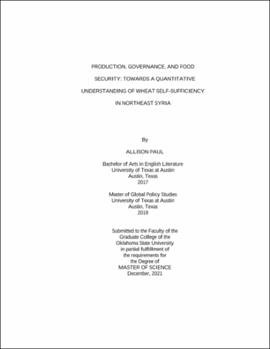| dc.contributor.advisor | Vitale, Jeffrey | |
| dc.contributor.author | Paul, Allison | |
| dc.date.accessioned | 2022-05-13T19:05:19Z | |
| dc.date.available | 2022-05-13T19:05:19Z | |
| dc.date.issued | 2021-12 | |
| dc.identifier.uri | https://hdl.handle.net/11244/335784 | |
| dc.description.abstract | Northeast Syria is a semi-autonomous region under the control of the Kurdish self-administration resulting from the ongoing Syrian Civil War. While relations with the Assad administration have somewhat normalized, the Kurdish self-administration still faces possible involuntary economic self-sufficiency if they seek independence. Using a two-pillar approach, this study explores the possibility of wheat self-sufficiency in Northeast Syria through understanding the production capacity and governance institutions in place. As true self-sufficiency should result in food security, this paper also measures current household wheat security to better understand the current level of self-sufficiency. | |
| dc.description.abstract | Using secondary quantitative data, this paper first looks at the wheat production capacity in Northeast Syria. This research finds that wheat yield in Syria is slightly correlated with rainfall. Furthermore, the research determines the average number of hectares planted for wheat in Northeast Syria would theoretically be sufficient to feed the population based on low or medium yields. | |
| dc.description.abstract | For the second pillar, governance, the study looks at both production and end line consumer prices for flour as a critical success factor for understanding the current governance structures that regulate the wheat cycle. For consumer flour pricing, this paper specifically looks at the differences between public and private bakeries before and after the Syria Caesar Civilian Protection Act of 2020, the most recent sanctions from the United States. Results show that the public bakeries offer lower prices in the short run; however, research in agricultural development indicate that this may not be sustainable in the long run. | |
| dc.description.abstract | Ultimately, this paper measures current food security as a function of flour, looking at the total household expenditure on flour using Smith and Subandoro's method of expenditure thresholds. Households that spend more than 6% of total income on flour are considered insecure; for the average Syrian household, flour expenditures amount to 6.5%, indicating high food insecurity. Contextualized within the larger food security narrative, indeed the Syrian population in the Northeast still face considerable barriers to food security, indicating that self-sufficiency is still not quite within grasp for the self-administration. | |
| dc.format | application/pdf | |
| dc.language | en_US | |
| dc.rights | Copyright is held by the author who has granted the Oklahoma State University Library the non-exclusive right to share this material in its institutional repository. Contact Digital Library Services at lib-dls@okstate.edu or 405-744-9161 for the permission policy on the use, reproduction or distribution of this material. | |
| dc.title | Production, governance, and food security: Towards a quantitative understanding of wheat self-sufficiency in Northeast Syria | |
| dc.contributor.committeeMember | Rich, Karl | |
| dc.contributor.committeeMember | Riley, John Michael | |
| osu.filename | Paul_okstate_0664M_17474.pdf | |
| osu.accesstype | Open Access | |
| dc.type.genre | Thesis | |
| dc.type.material | Text | |
| dc.subject.keywords | agricultural economics | |
| dc.subject.keywords | agriculture | |
| dc.subject.keywords | international agriculture | |
| dc.subject.keywords | syria | |
| thesis.degree.discipline | International Agriculture | |
| thesis.degree.grantor | Oklahoma State University | |
